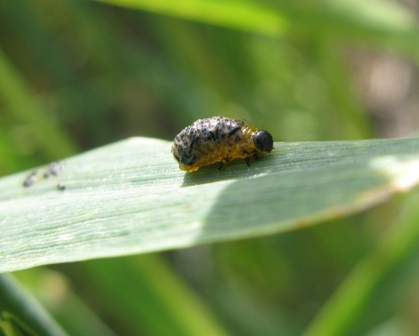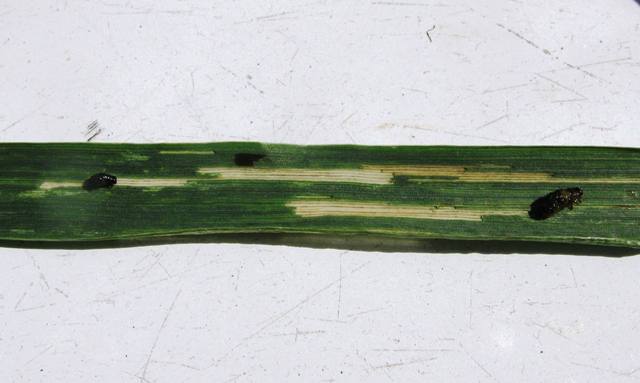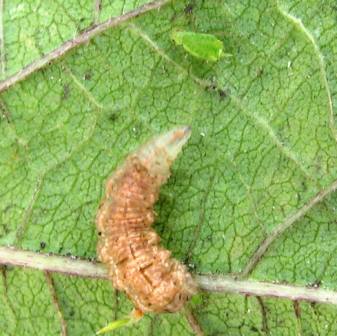Manitoba Insect & Disease Update
Issue 6: June 22, 2016
Summary
Insects: Cutworm and flea beetle levels and damage continues to decline. Alfalfa weevil is being noted at high levels in some alfalfa fields.
Plant Pathogens: Cereal rust diseases continue to develop and spread in Canada and the United States.
Current insects to focus on when scouting crops
Alfalfa: Alfalfa weevil levels have been quite high in many fields. Alfalfa weevil larvae do not have legs, so can not move too far. Because of this early cutting is often an effective management strategy in hay crops. In seed crops management can be difficult. Insecticides are registered but often are not highly effective on alfalfa weevil.
Cereal Crops: Barley thrips are quite noticeable in some barley fields in Eastern Manitoba. To look for these, unroll the leaf sheaths away from the stem to look for the thrips. Most thrips will be under the top 2 leaf sheaths. Sampling for barley thrips is advised from when the flag leaf is first visible until the head is completely emerged from the boot.
Low levels of English gain aphid and oat-birdcherry aphid are being found in some fields. So far no fields have been reported near the threshold of 12 to 15 aphids per stem on average. Natural enemies can be found in some of these fields, including aphid mummies, which are the remains of aphids that have been parasitized by parasitic wasps. Heavy rains can also help reduce aphid levels.
Cereal Leaf Beetles Needed: Low levels of cereal leaf beetle have also been found in some fields. A parasitic wasp called Tetrastichus julis, which is specific to cereal leaf beetle, has been released in Manitoba in the past few years. It seems to be establishing well, and hopefully will keep populations at sub-economic levels. We are hoping to once again collect cereal leaf beetle larvae and determine the percent of larvae that are parasitized from fields in various regions. So if you are noticing any cereal leaf beetle larvae on wheat, oats, barley, or any other cereal crop, please collect a sample or let me know so we can collect some and determine the level of parasitism in the population. Areas that may have low levels of parasitism would be considered for possible future releases of the parasitoid. Ideally a sample of at least 30 larvae is good for estimating percent parasitism. They can be collected off the plant or in a sweep net. Place some food for them in the container as well. The larvae often have a fecal coating over them, and may look like a drop of oil on the plant.


Figure 1. Larva of cereal leaf beetle. Figure 2. Feeding from cereal leaf beetle.
Pulse Crops: Pea aphid is showing up in some pea crops. Whether it would be economical to use an insecticide to manage aphids in peas depends on the levels that is present. The economic threshold is: If, at the beginning of flowering, there are 9 to 12 aphids per sweep or 2-3 aphids per 8-inch (20 cm) plant tip, an insecticide application when 50 percent of plants have produced some young pods will be cost-effective. Whether aphid levels increase, and to what extent, depend on the levels of natural enemies that are present, and possibly weather conditions (heavy rains can sometimes decrease a population).
To date there have been no reports of soybean aphids in Manitoba this year.
Diseases of cereal crops
According to recent cereal rust survey reports, stripe rust in wheat was reported in four provinces in Canada and 31 states in the United States. In Canada, stripe rust was reported in Manitoba, Alberta, Ontario and Saskatchewan. Both stripe rust and leaf rust in wheat were reported in Manitoba. An optimal temperature for stripe rust development is 0-25 C and 15-25 C for leaf rust development. Scouting for all cereal rust diseases should be continued.
Bacterial blight symptoms in winter wheat and oats were also reported from Manitoba Agriculture’s Crop Diagnostic lab.
Soybean diseases
Root rot pathogens continue to cause problems in soybean fields. Many soybean samples exhibiting root rot symptoms were submitted to Manitoba Agriculture’s Crop Diagnostic lab in the last week. Fusarium spp were the most common pathogen isolated from the submitted samples. In addition to Fusarium sps, Rhizoctonia spp and Phytophthora sojae were also isolated from soybean samples.
Canola diseases
Low incidence of blackleg was found in a research plot in Carman area.
Rhizoctonia spp infected canola plants were also submitted to Manitoba Agriculture’s Crop Diagnostic Laboratory.
Sunflower diseases
Pythium root rot and phomopsis was found in a sunflower sample submitted to Crop Diagnostic Laboratory.
Refer to Guide to Field Crop Protection for information on fungicides registered for various field crops.
Insect Identification Quiz
Question: A couple of enquiries have come in recently regarding these slug-like animals on plants, that seem to be probing around with their narrower tapered end. What are these?

Answer: These are larvae of hover flies. They are predators. One of their favorite foods is aphids. You will note that they have no legs. The tapered end is their head of the insect. If you see them near an aphid colony, you may get to witness them impaling an aphid, holding it up and sucking the fluids out of it - super fun to watch while out crop scouting.
Insect Monitoring Programs
Diamondback Moth: Numbers of adult moths caught in traps in most regions generally do not suggest a high risk of more widespread economic populations. For those scouting canola and cruciferous crops in the Northwest, Eastern and Central Manitoba, examining plants for diamondback moth larvae is encouraged as localized economical populations could occur. Risk in the Southwest and Interlake is currently low. Once diamondback moth adults are moved into an area on wind currents, factors such as weather conditions and natural enemies will determine how successful larvae become established.
Low levels of larvae of diamondback moth began to be noticed in mid-June. So far no levels of larvae near or above the economic threshold have been reported.
Table 1. Highest cumulative trap counts per region over the trapping period (May 1 to June 22, 2016):
| Location | Count |
|---|---|
| Northwest | |
| Minitonas | 237 |
| The Pas | 168, 163, 97 |
| Ste. Rose | 110 |
| Southwest | |
| Justice | 25 |
| Franklin | 12 |
| Hamiota | 11 |
| Central | |
| Elm Creek | 83 |
| Neuenberg | 83 |
| Myrtle | 78 |
| Eastern | |
| Morris | 123 |
| Rosenort | 87 |
| Howden | 63 |
| Interlake | |
| Grahamdale | 42 |
| E. Selkirk | 16 |
| Lundar | 11 |
A summary of diamondback moth monitoring in Manitoba, and more detailed interpretation, can be found at:
http://www.gov.mb.ca/agriculture/crops/insects/diamondback-moth-forecast.html The last week of trap counts for diamondback moth is the week of June 19-25. So traps for diamondback moth can be pulled after your next counts.
Bertha armyworm: So far cumulative trap counts for bertha armyworm are all in the low risk range (less than 300). Highest counts, as of June 22 are:
| Location | Count |
|---|---|
| Benito | 120 |
| Roblin | 91 |
| Minto | 87 |
| Tummel | 74 |
Compiled by:
John Gavloski, Entomologist Pratisara Bajracharya, Field Crop Pathologist
Manitoba Agriculture Manitoba Agriculture
Phone: (204) 745-5668 Phone: (204) 750-4248
To report observations on insects or plant pathogens that may be of interest or importance to farmers and agronomists in Manitoba, please send messages to the above contacts.
To be placed on an E-mail list so you will be notified immediately when new Manitoba Insect and Disease Updates are posted, please contact John Gavloski .

